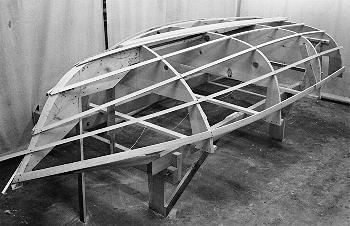
In general: Foam-sandwich construction in the following assumes the use of the pure polyvinyl-chloride rigid-elastic type of 5 to 6 lbs. per cubic foot density. Chemically blown cross-linked PVC foams as well as polyurethane foams do not have the same charateristics and will not necessarily function or react the same as pure PVC types. In foam-sandwich construction, the PVC foam is applied in sheet form over a male mold or form to make the hull of the boat. The FORM is a by-product and does not remain in the finished hull. The foam acts as a core material over which fiberglass material and resin are applied to both sides, thereby forming a rigid and strong sandwich-type of construction. See Useful Information & Suppliers for sources of foam core materials.

Fig. 1 The form members are erected on a building form, accurately aligned, and braced to prevent movement. The traverse forms usually conform to the stations, and must be vertical, at right angles to the centerline, and centered. All members must be level about the centerline, and centered. All members must be level about the set-up level or reference plane. The form member edges often require beveling so that the longitudinal battens or ribbands will mate flat, and not just rest on corners. Note the bevels on each side of the stem form member. Several widely spaced battens are applied initially in order to determine the approximate positions for the balance of the battens onto the stem form. The keel batten is tapered forward so the adjacent battens will form a fair curve onto the stem form.

Fig. 2 The ribbands are located directly adjacent to the keel and sheer members to support the edges of the foam. The keel and sheer members protrude above the level of the ribbands to match the thickness of the foam. The ends of the battens along the stem form are trimmed off and then built up with wood laminations or other material to form a stern cap. This material is then faired and radiused to contour to be flush with the level of the foam. The foam is omitted in these areas along the stem, keel and sheer, and made of solid fiberglass laminate joining both the inner and outer skins once the hull is completed. The plywood strap shown between the stem and forward transverse form is used to prevent ribbands from "twisting" unfairly. Continue